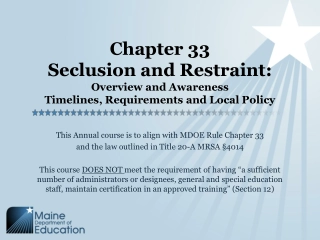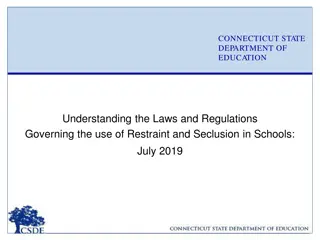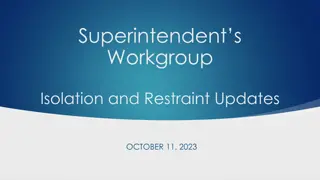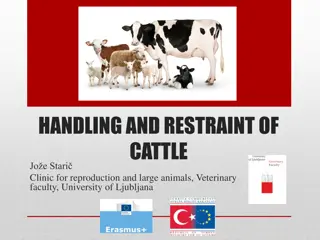Understanding and Managing After-School Restraint Collapse in Children
After-school restraint collapse is a phenomenon where children experience emotional meltdowns after holding in their feelings all day at school. This survival guide explains the causes and offers tips on how to support children through this challenging transition period, emphasizing the importance of meeting their basic needs and helping them regulate their emotions.
Download Presentation

Please find below an Image/Link to download the presentation.
The content on the website is provided AS IS for your information and personal use only. It may not be sold, licensed, or shared on other websites without obtaining consent from the author. Download presentation by click this link. If you encounter any issues during the download, it is possible that the publisher has removed the file from their server.
E N D
Presentation Transcript
After school restraint collapse: a survival guide
Ever wondered what happens in school? You send your smartly dressed little angel into school in the morning, and they return a wild child who seems to overreact to everything! After school restraint collapse has become much more widely discussed in recent years. It describes how young children placed in a demanding environment often collapse into tantrums or meltdowns as soon as they re with familiar people.
Experiencing restraint collapse What we need to remember is, for them, the sandwich or changing out of their uniform is the tip of a huge iceberg. It is at that point that the lid flips. They just can t contain any more of their emotions. Restraint collapse happens when, having relaxed a little, everything they have been suppressing all day comes tumbling out. They have been without you all day. They were jostled in a line, had to sit when they wanted to stand. Perhaps, they were outside when they wanted to be inside, or inside when they wanted to be outside. They had to listen, but they didn t understand; they had to focus and take on new information. Finally, now, they re done. This is after school restraint collapse. It isn t really about the sandwich. You could have shaped the sandwich into a scale model of a triceratops and it would still have been wrong. They need to let it out. Young children don t have the capacity to tell you what is wrong. They don t have the capacity to just calm down . They are emotionally overwhelmed, in a state of meltdown, and they need your help to regulate.
So, what can we do? We can meet their basic needs - Food, drink, toileting, space, If possible encouraging them to eat, drink and go to the toilet raises the flashpoint that triggers the emotional explosions. Meeting their basic needs gives you a little more leeway. You may have a few extra moments to intervene and head off another tantrum or meltdown. Meeting their basic needs creates a space for talking, hugging, and other ways to help them manage their feelings before they re overwhelmed. We can be there for them -Calm: developing emotional regulation- ZOR Naming and talking about emotions helps children develop their emotional vocabulary. In time they will start to use words to describe how they feel before they reach meltdown. Managing our own triggers recognise our own emotions- tired, run down, On the other hand, when we shout and scream back at our child during a meltdown, they also feel rejected. They see that they re not loved when they express such big emotions. Instead of learning to self-regulate and avoid meltdowns they learn to fear their emotions. In addition to school they try to suppress their emotions at home. Suppressing emotions: a dangerous game show all types of emotions Responding with anger or shame increases our children s fear around emotions. Some children never learn to process their emotions or deal calmly with them. They can t recognise their emotions and what they communicate; or verbalise their feelings and cooperate with others to change the situation to meet everyone s needs. Instead, they bury their emotions.
Work out what works for them Decompression and demand free time -My oldest child needed around an hour after school to curl up in a blanket fort, or on the sofa. She needed a big snack. We did a small snack on the walk home from school and a big snack at home. She needed to zone out. She might watch TV or play on a tablet. An hour with no demands, no chat, nor any questions about his day. Ideally, she d do this with me sitting next to him, snuggled up. Often I could leave after ten minutes or so if needs be. Running around -This may not work for your child. Especially, for older children, where sitting still is a bigger part of their day. For them running around may be key. Going for a walk, visiting the park, or playing in the garden may work well. Reconnection- If this can be with you to build in some quality time together this can help hugely with reconnecting. It gives you something to laugh about with them, and to reflect on as a positive at the end of the day.
Be ready for bedtime I don t just mean fantasizing about the cuppa and chocolate bar, although I know that feeling. Space to process -It doesn t matter how many times you ask your child about their day earlier on. It is at bedtime, as they start to relax, that the worries come out. Bedtime is often when kids are often best able to talk about how they feel. This can be incredibly frustrating for tired parents who need to relax. However, it s really important to hold that space for them to open up. Allow time to listen - If it takes a long time to talk over their feelings and experiences each night, factor that into bedtime. Facilitate it by going upstairs 15 minutes earlier. Listen to what they are saying, empathise with them, name emotions. It doesn t need to be a big discussion. Sometimes feeling heard will be enough for them to relax and fall asleep. Resolving issues -Sometimes it will throw up issues that do need to be addressed at another time. That might mean having a more in-depth conversation about expectations at school. Or you may need to speak to the school to let them know of your concerns and what your child is struggling with. It may help them to be aware and they should be able to support them with any issues. Let your child know that you ll help them with their problem the next morning. Building your relationship -Try to be patient with them. As parents we want our children to come to us with their worries. Discouraging them from talking about their concerns risks them feeling unable to talk to us in the future. Lying next to them whilst they recount the day can be a lovely moment, too.
Further information After school restraint collapse: a survival guide CalmFamily https://itsaslingthing.co.uk/after-school-stress/ https://www.handyhandouts.com/pdf/686_HomeMeltdowns.pdf https://www.sensorydirect.com/blog/top-tips-for-managing-after-school- meltdowns/























